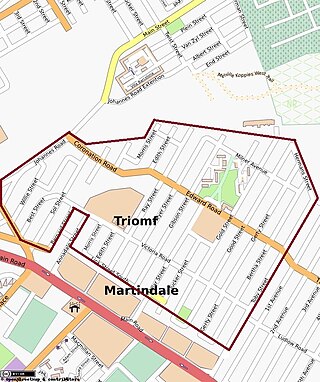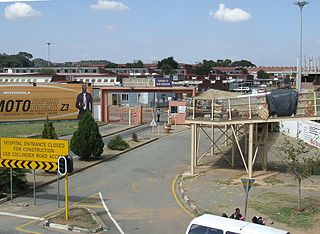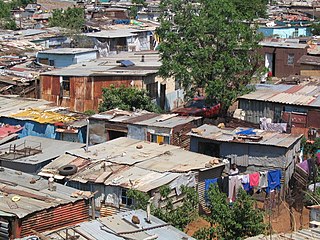
Soweto is a township of the City of Johannesburg Metropolitan Municipality in Gauteng, South Africa, bordering the city's mining belt in the south. Its name is an English syllabic abbreviation for South Western Townships. Formerly a separate municipality, it is now incorporated in the City of Johannesburg Metropolitan Municipality, and one of the suburbs of Johannesburg.

Johannesburg is a large city in Gauteng Province of South Africa. It was established as a small village controlled by a Health Committee in 1886 with the discovery of an outcrop of a gold reef on the farm Langlaagte. The population of the city grew rapidly, becoming a municipality in 1898. In 1928 it became a city making Johannesburg the largest city in South Africa. In 2002 it joined ten other municipalities to form the City of Johannesburg Metropolitan Municipality. Today, it is a centre for learning and entertainment for all of South Africa. It is also the capital city of Gauteng.
Aggrey Zola Klaaste OMSG was a South African newspaper journalist and editor. He was best known for being editor of the Soweto-based newspaper, the Sowetan, from 1988 to 2002. He introduced the concept of "nation building" while editor of the Sowetan and spent much of his time and energy promoting the idea.

Sophiatown, also known as Sof'town or Kofifi, is a suburb of Johannesburg, South Africa. Sophiatown was a black cultural hub that was destroyed under apartheid, It produced some of South Africa's most famous writers, musicians, politicians and artists. Rebuilt under the name of Triomf, and in 2006 officially returned to its original name. Sophiatown was one of the oldest black areas in Johannesburg and its destruction represents some of the excesses of South Africa under apartheid.
Dobsonville is a township in greater Soweto, Johannesburg, South Africa. It lies to the west of Meadowlands, a part of Diepmeadow, and is adjacent to Mofolo North and Zondi, which are suburbs of Soweto on its southern border.

The suburbs of Johannesburg are officially demarcated areas within the City of Johannesburg Metropolitan Municipality, South Africa. As in other Commonwealth countries, the term suburb refers to a "neighbourhood", although in South Africa most "suburbs" have legally recognised borders and often separate postal codes. The municipal functions for the area, such as municipal policing and social services, are still managed by the city government.

The City of Johannesburg Metropolitan Municipality is a metropolitan municipality that manages the local governance of Johannesburg, the largest city in South Africa. It is divided into several branches and departments in order to expedite services for the city. Zulu is the most spoken home language at 23.4% followed by English at 20.1%.

Diepkloof is a large zone of Soweto township in the Gauteng province of South Africa. It is also sometimes referred to as Diepmeadow, if considered as a single township with the nearby Meadowlands. Diepkloof was established in 1959 to accommodate people being removed from Alexandra.
Group Areas Act was the title of three acts of the Parliament of South Africa enacted under the apartheid government of South Africa. The acts assigned racial groups to different residential and business sections in urban areas in a system of urban apartheid. An effect of the law was to exclude people of color from living in the most developed areas, which were restricted to Whites. It required many people of color to commute large distances from their homes to be able to work. The law led to people of color being forcibly removed for living in the "wrong" areas. People of colour, who were the majority at the time, were given much smaller areas to live in than the white minority who owned most of the country. Pass Laws required people of color to carry pass books and later "reference books", similar to passports, to enter the "white" parts of the country.

Thembisa, formerly Tembisa, is a large township situated to the north of Kempton Park on the East Rand, Gauteng, South Africa. It was established in 1957 when black people were resettled from Alexandra and other areas in Edenvale, Kempton Park, Midrand and Germiston.
Tsotsitaal is a vernacular derived from a variety of mixed languages mainly spoken in the townships of Gauteng province, but also in other agglomerations all over South Africa. Tsotsi is a Sesotho, Pedi or Tswana slang word for a "thug" or "robber" or "criminal", possibly from the verb "ho lotsa" "to sharpen", whose meaning has been modified in modern times to include "to con"; or from the tsetse fly, as the language was first known as Flytaal, although flaai also means "cool" or "street smart". The word taal in Afrikaans means "language".

The Natives Resettlement Act, Act No 19 of 1954, formed part of the apartheid system of racial segregation in South Africa. It permitted the removal of blacks from any area within and next to the magisterial district of Johannesburg by the South African government. This act was designed to remove blacks from Sophiatown to Meadowlands.
Meadowlands Secondary School is a government secondary school in Meadowlands a section of Soweto.

The Tutu House is a house on Vilakazi Street in Soweto, Johannesburg, South Africa, that was the home to Desmond and Leah Tutu. The house is registered as part of Johannesburg's historical heritage.
Noordgesig is a township in Soweto, situated at the edge of area's northernmost boundary, but within its territory. It is the first township seen on entering Soweto from the frequently used New Canada Road. Noordgesig is a Coloured township. It is colloquially called "Bulte"(meaning Hills) by its residence and neighbors, as depicted by the Mine Dumps surrounding the Township. The name "Bulte" was coined as a form of endearment by the residence for the longest time.

The apartheid regime in South Africa began in 1948 and lasted until 1994. It involved a system of institutionalized racial segregation and white supremacy, and placed all political power in the hands of a white minority. Opposition to apartheid manifested in a variety of ways, including boycotts, non-violent protests, and armed resistance. Music played a large role in the movement against apartheid within South Africa, as well as in international opposition to apartheid. The impacts of songs opposing apartheid included raising awareness, generating support for the movement against apartheid, building unity within this movement, and "presenting an alternative vision of culture in a future democratic South Africa."
"Meadowlands" was an anti-apartheid song composed in 1956 by Strike Vilakazi. It was written in reaction to the forced relocation of black South Africans from Sophiatown, to the new township of Meadowlands. The song was popularised by a number of musicians, including Dorothy Masuka and Miriam Makeba, and became an anthem of the movement against apartheid.
Strike David Vilakazi was a South African vocalist, drummer, trumpeter, composer, and music producer. He was known for composing the anti-apartheid song "Meadowlands", and for his career as a producer, during which he was influential in the development of mbaqanga.
Nomhlangano Beauty Mkhize was a South African activist, politician, shop steward and wife to late Saul Mkhize. She was born in Sophia Town and she was forcibly removed to Meadowlands in Soweto and that's where she met her husband.

Slum clearance in South Africa has been used as an urban renewal strategy to regenerate derelict or run-down districts, often to be replaced with alternative developments or new housing.












